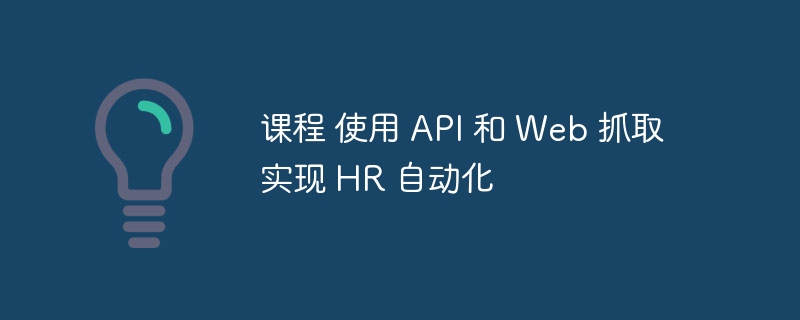课程 使用 API 和 Web 抓取实现 HR 自动化

欢迎回到我们的python从0到英雄系列!到目前为止,我们已经学习了如何操作数据并使用强大的外部库来执行与工资和人力资源系统相关的任务。但是,如果您需要获取实时数据或与外部服务交互怎么办?这就是api和网络抓取发挥作用的地方。
在本课中,我们将介绍:
- api是什么以及它们为何有用。
- 如何使用 python 的 requests 库与 rest api 交互。
- 如何应用网络抓取技术从网站提取数据。
- 实际示例,例如获取工资的实时税率或从网站抓取员工福利数据。
在本课程结束时,您将能够自动化外部数据检索,使您的 hr 系统更加动态和数据驱动。
1.什么是api?
api(应用程序编程接口)是一组允许不同软件应用程序相互通信的规则。简而言之,它允许您直接从代码与另一个服务或数据库交互。
例如:
- 您可以使用 api 获取实时税率以进行工资计算。
- 您可以与人力资源软件 api 集成,将员工数据直接提取到您的系统中。
- 或者您可以使用天气 api 来了解何时根据极端天气条件为员工提供特殊福利。
大多数 api 使用名为 rest(表述性状态传输)的标准,它允许您发送 http 请求(如 get 或 post)来访问或更新数据。
2. 使用requests库与api交互
python 的 requests 库让 api 的使用变得简单。您可以通过运行来安装它:
pip install requests
发出基本 api 请求
让我们从一个简单的示例开始,了解如何使用 get 请求从 api 获取数据。
import requests
# example api to get public data
url = "https://jsonplaceholder.typicode.com/users"
response = requests.get(url)
# check if the request was successful (status code 200)
if response.status_code == 200:
data = response.json() # parse the response as json
print(data)
else:
print(f"failed to retrieve data. status code: {response.status_code}")
在此示例中:
- 我们使用 requests.get() 函数从 api 获取数据。
- 如果请求成功,数据会被解析为json,我们就可以处理它了。
hr应用示例:获取实时税务数据
假设您想要获取实时税率以用于工资核算。许多国家提供了税率的公共 api。
在此示例中,我们将模拟从税务 api 获取数据。使用实际 api 时的逻辑是类似的。
import requests
# simulated api for tax rates
api_url = "https://api.example.com/tax-rates"
response = requests.get(api_url)
if response.status_code == 200:
tax_data = response.json()
federal_tax = tax_data['federal_tax']
state_tax = tax_data['state_tax']
print(f"federal tax rate: {federal_tax}%")
print(f"state tax rate: {state_tax}%")
# use the tax rates to calculate total tax for an employee's salary
salary = 5000
total_tax = salary * (federal_tax + state_tax) / 100
print(f"total tax for a salary of ${salary}: ${total_tax:.2f}")
else:
print(f"failed to retrieve tax rates. status code: {response.status_code}")
此脚本可以修改为与实际税率 api 配合使用,帮助您使工资系统保持最新的税率。
3. 网页抓取来收集数据
虽然 api 是获取数据的首选方法,但并非所有网站都提供它们。在这些情况下,网络抓取可用于从网页中提取数据。
python 的 beautifulsoup 库以及请求使网络抓取变得简单。您可以通过运行来安装它:
pip install beautifulsoup4
示例:从网站抓取员工福利数据
想象一下您想要从公司的人力资源网站上抓取有关员工福利的数据。这是一个基本示例:
import requests from bs4 import beautifulsoup # url of the webpage you want to scrape url = "https://example.com/employee-benefits" response = requests.get(url) # parse the page content with beautifulsoup soup = beautifulsoup(response.content, 'html.parser') # find and extract the data you need (e.g., benefits list) benefits = soup.find_all("div", class_="benefit-item") # loop through and print out the benefits for benefit in benefits: title = benefit.find("h3").get_text() description = benefit.find("p").get_text() print(f"benefit: {title}") print(f"description: {description}\n")
在此示例中:
此技术对于从网络收集与人力资源相关的数据(例如福利、职位发布或薪资基准)非常有用。
4. 在 hr 应用程序中结合 api 和 web 抓取
让我们将所有内容放在一起,创建一个结合 api 使用和 web 抓取的迷你应用程序,用于真实的 hr 场景:计算员工的总成本。
我们会:
- 使用 api 获取实时税率。
- 抓取网页以了解额外的员工福利费用。
示例:员工总成本计算器
import requests from bs4 import BeautifulSoup # Step 1: Get tax rates from API def get_tax_rates(): api_url = "https://api.example.com/tax-rates" response = requests.get(api_url) if response.status_code == 200: tax_data = response.json() federal_tax = tax_data['federal_tax'] state_tax = tax_data['state_tax'] return federal_tax, state_tax else: print("Error fetching tax rates.") return None, None # Step 2: Scrape employee benefit costs from a website def get_benefit_costs(): url = "https://example.com/employee-benefits" response = requests.get(url) if response.status_code == 200: soup = BeautifulSoup(response.content, 'html.parser') # Let's assume the page lists the monthly benefit cost benefit_costs = soup.find("div", class_="benefit-total").get_text() return float(benefit_costs.strip("$")) else: print("Error fetching benefit costs.") return 0.0 # Step 3: Calculate total employee cost def calculate_total_employee_cost(salary): federal_tax, state_tax = get_tax_rates() benefits_cost = get_benefit_costs() if federal_tax is not None and state_tax is not None: # Total tax deduction total_tax = salary * (federal_tax + state_tax) / 100 # Total cost = salary + benefits + tax total_cost = salary + benefits_cost + total_tax return total_cost else: return None # Example usage employee_salary = 5000 total_cost = calculate_total_employee_cost(employee_salary) if total_cost: print(f"Total cost for the employee: ${total_cost:.2f}") else: print("Could not calculate employee cost.")
运作原理:
- get_tax_rates() 函数从 api 检索税率。
- get_benefit_costs() 函数会抓取网页以获取员工福利成本。
- calculate_total_employee_cost() 函数通过结合工资、税收和福利来计算总成本。
这是一个简化的示例,但演示了如何组合来自不同来源(api 和网络抓取)的数据来创建更加动态和有用的 hr 应用程序。
网页抓取的最佳实践
虽然网页抓取功能强大,但仍需要遵循一些重要的最佳实践:
- 尊重网站的robots.txt:有些网站不允许抓取,你应该在抓取之前检查他们的robots.txt文件。
- 在请求之间使用适当的间隔:通过使用 time.sleep() 函数在请求之间添加延迟来避免服务器过载。
- 避免抓取敏感或受版权保护的数据:始终确保抓取数据时没有违反任何法律或道德规则。
结论
在本课程中,我们探讨了如何使用 api 与外部服务交互,以及如何通过 网络抓取 从网站提取数据。这些技术为将外部数据集成到 python 应用程序中提供了无限的可能性,尤其是在 hr 环境中。
以上就是课程 使用 API 和 Web 抓取实现 HR 自动化的详细内容,更多请关注其它相关文章!
